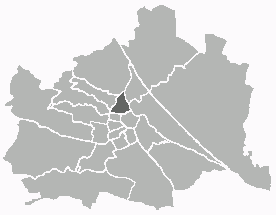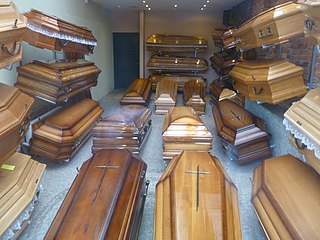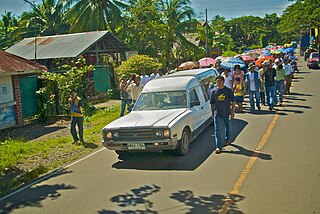History and description
When the Austro-Hungarian Empire was at its peak, people paid heavily to make sure they would be remembered. Their obsession of a "schöne Leiche" (a beautiful corpse) prompted them to save money to ensure their send off was as grand as possible. In Vienna in the 1900s more than eighty private funeral companies competed for the business of burying the city's citizens in one of the 52 cemeteries in the suburban area.
In 1951 the Bestattung Wien, or Undertaking Service of Vienna, was appointed as the only funeral company in the city. The museum was founded in 1967 and designed in 1987 by Wittigo Keller.
Located in the 4th district at Goldeggasse 19, near the Belvedere, Vienna, it also houses the intriguing Vienna Undertakers' Museum, which contains more than 600 artifacts documenting the Viennese interest in death and burial.
There are elaborate black uniforms and regalia worn by the pallbearers, from the French pompes funèbres, as well as hearses, wreaths, sashes, lanterns, torches, black flags, even an urn in the shape of a football and a "sitting coffin". [1]
A real curiosity on display in the Bestattungsmuseum is the re-usable coffin instigated in 1784 by Emperor Joseph II, in an attempt to save wood and to hasten decomposition. The coffins were equipped with a trap underneath to drop the bodies in the graves and kept for another funeral. But the Viennese protests led to the cancellation of the law within six months. With court decree of 29 May 1825, it was decreed that every deceased had to be placed in a sealed coffin before being lowered into the ground. [2]
Another curiosity is a device whereby a cord; attached to the hand of the deceased would ring a bell above ground to prevent premature burial, just in case the person wasn't really dead. To avoid this, some Viennese stipulated in their will that after death they should be stabbed in the heart with a sword. To this day, the city's hospital is still occasionally instructed to administer a lethal injection after death to avoid premature burial.

A funeral is a ceremony connected with the final disposition of a corpse, such as a burial or cremation, with the attendant observances. Funerary customs comprise the complex of beliefs and practices used by a culture to remember and respect the dead, from interment, to various monuments, prayers, and rituals undertaken in their honour. Customs vary between cultures and religious groups. Funerals have both normative and legal components. Common secular motivations for funerals include mourning the deceased, celebrating their life, and offering support and sympathy to the bereaved; additionally, funerals may have religious aspects that are intended to help the soul of the deceased reach the afterlife, resurrection or reincarnation.

Alsergrund is the ninth district of Vienna, Austria. It is located just north of the first, central district, Innere Stadt. Alsergrund was incorporated in 1862, with seven suburbs. As a central district, the area is densely populated. According to the census of 2001, there were 37,816 inhabitants over 2.99 square km.

Burial, also known as interment or inhumation, is a method of final disposition whereby a dead body is placed into the ground, sometimes with objects. This is usually accomplished by excavating a pit or trench, placing the deceased and objects in it, and covering it over. A funeral is a ceremony that accompanies the final disposition. Evidence suggests that some archaic and early modern humans buried their dead. Burial is often seen as indicating respect for the dead. It has been used to prevent the odor of decay, to give family members closure and prevent them from witnessing the decomposition of their loved ones, and in many cultures it has been seen as a necessary step for the deceased to enter the afterlife or to give back to the cycle of life.

A coffin is a funerary box used for viewing or keeping a corpse, either for burial or cremation.

St. Stephen's Cathedral is the mother church of the Roman Catholic Archdiocese of Vienna and the seat of the Archbishop of Vienna, Christoph Cardinal Schönborn, OP. The current Romanesque and Gothic form of the cathedral, seen today in the Stephansplatz, was largely initiated by Duke Rudolf IV (1339–1365) and stands on the ruins of two earlier churches, the first a parish church consecrated in 1147. The most important religious building in Vienna, St. Stephen's Cathedral has borne witness to many important events in Habsburg and Austrian history and has, with its multi-coloured tile roof, become one of the city's most recognizable symbols. It has 256 stairs from the top to the bottom

Simmering is the 11th district of Vienna, Austria. It borders the Danube and was established as a district in 1892. Simmering has several churches, some museums, schools, old castles, and four cemeteries, one of them being the Wiener Zentralfriedhof, one of the largest cemeteries of Europe.

Leopoldstadt is the 2nd municipal district of Vienna in Austria. As of 1 January 2016, there are 103,233 inhabitants over 19.27 km2 (7 sq mi). It is situated in the heart of the city and, together with Brigittenau, forms a large island surrounded by the Danube Canal and, to the north, the Danube. It is named after Leopold I, Holy Roman Emperor. Due to its relatively high percentage of Jewish inhabitants before the Holocaust, Leopoldstadt gained the nickname Mazzesinsel. This context was a significant aspect for the district twinning with the New York City borough Brooklyn in 2007.

The Vienna Central Cemetery is one of the largest cemeteries in the world by number of interred, and is the most well-known cemetery among Vienna's nearly 50 cemeteries. The cemetery's name is descriptive of its significance as Vienna's biggest cemetery, not of its geographic location, as it is not in the city center of the Austrian capital, but on the southern outskirts, in the outer city district of Simmering.

Landstraße is the 3rd municipal district of Vienna, Austria. It is near the center of Vienna and was established in the 19th century. Landstraße is a heavily populated urban area with many workers and residential homes. It has 89,834 inhabitants in an area of 7.42 km2. It has existed since about 1200 AD. In 1192, the English king Richard the Lionheart was captured in the Erdberg neighbourhood, after the unsuccessful Third Crusade.

Roman funerary practices include the Ancient Romans' religious rituals concerning funerals, cremations, and burials. They were part of time-hallowed tradition, the unwritten code from which Romans derived their social norms. Elite funeral rites, especially processions and public eulogies, gave the family opportunity to publicly celebrate the life and deeds of the deceased, their ancestors, and the family's standing in the community. Sometimes the political elite gave costly public feasts, games and popular entertainments after family funerals, to honour the departed and to maintain their own public profile and reputation for generosity. The Roman gladiator games began as funeral gifts for the deceased in high status families.

St. Marx Cemetery is a cemetery in the Landstraße district of Vienna, used from 1784 until 1874. It contains the unmarked grave of the famous composer Wolfgang Amadeus Mozart.

Tung Wah Coffin Home is a coffin home located upon the hill above Sandy Bay on Hong Kong Island, in Hong Kong.

A Christian burial is the burial of a deceased person with specifically Christian rites; typically, in consecrated ground. Until recent times Christians generally objected to cremation because it interfered with the concept of the resurrection of a corpse, and practiced inhumation almost exclusively. Today this opposition has all but vanished among Protestants and Catholics alike, and this is rapidly becoming more common, although Eastern Orthodox Churches still mostly forbid cremation.

The Jewish Cemetery in Währing, opened in 1784, was the main burial site for members of the Israelitische Kultusgemeinde Wien. Besides the St. Marx Cemetery it is the last remaining cemetery of Vienna in the Biedermeier style. After its closure in the 1880s, it was partially destroyed during the time of the Third Reich, and is now only partly accessible due to its deteriorating condition. A long-running debate over the restoration of the cemetery has been taking place since 2006 between politicians of the federal and local levels as well as experts.

The Jewish cemetery in Roßau, which is also known at the Seegasse Jewish cemetery because of its location in the Seegasse, is the oldest preserved cemetery in Vienna. Members of the city's Jewish community were buried here between 1540 and 1783.

During the Pre-Hispanic period the early Filipinos believed in a concept of life after death. This belief, which stemmed from indigenous ancestral veneration and was strengthened by strong family and community relations within tribes, prompted the Filipinos to create burial customs to honor the dead through prayers and rituals. Due to different cultures from various regions of the Philippines, many different burial practices have emerged. For example, the Manobos buried their dead in trees, the Ifugaos seated the corpse on a chari before it was brought to a cave and buried elsewhere. The most common forms of traditional burials are supine pits, earthenware jars, and log coffins, and have been a topic of interest among Philippine archaeologists since the early 20th century.

Matzleinsdorf Protestant Cemetery is a historic church-owned and operated Protestant cemetery located in the Favoriten district of Vienna, the capital city of Austria.
The Bestattung Wien is Austria's leading funeral director, and one of the largest in Europe.

Feuerhalle Simmering is a crematorium with attached urn burial ground in the Simmering district of Vienna, Austria. It lies at the end of an alley, directly opposite Vienna Central Cemetery's main gate.

The economy coffin, hinged coffin or Josephinian coffin was a type of reusable coffin introduced by Joseph II, Holy Roman Emperor in the late 18th century. The body was carried in the coffin to the gravesite where it would be dropped into the grave through folding doors on the base. The coffin would then be reused.





















